Taxation Law Assignment: CGT Event Analysis and Tax Calculation
VerifiedAdded on 2022/08/20
|7
|872
|15
Homework Assignment
AI Summary
This document presents a detailed analysis of a Taxation Law assignment, focusing on Capital Gains Tax (CGT) events. The assignment explores scenarios involving the sale of investment property and a share portfolio, analyzing the timing of CGT events based on relevant legislation and case law, including references to the Income Tax Assessment Act 1997 (ITAA 1997) and the case of FCT v Sara Lee Household & Body Care P/L (2000). The solution calculates tax liabilities using both the discount and indexation methods, providing recommendations for minimizing tax obligations. The document includes references to key legal texts and provides a comprehensive understanding of CGT principles and their practical application in the given case study.
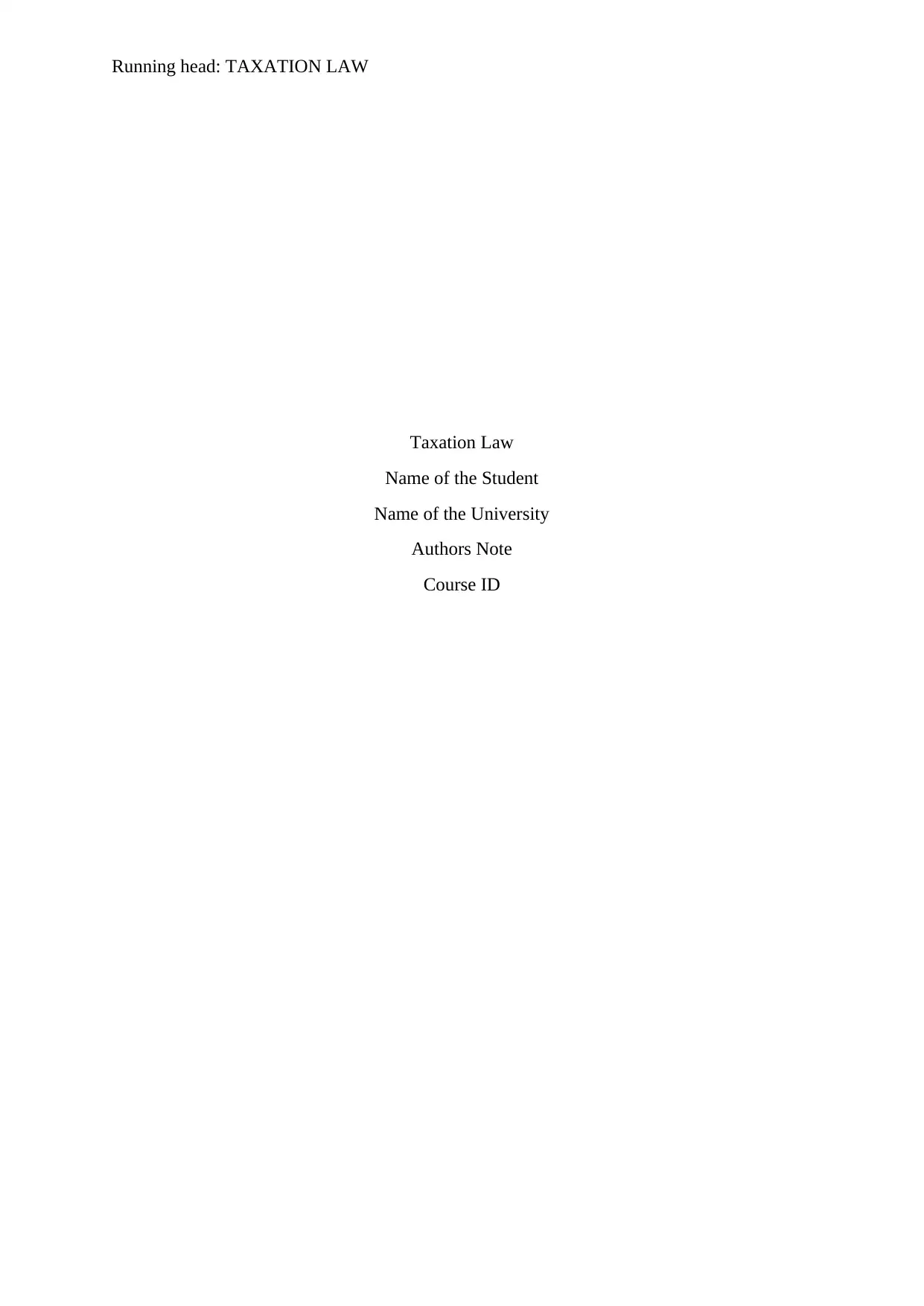
Running head: TAXATION LAW
Taxation Law
Name of the Student
Name of the University
Authors Note
Course ID
Taxation Law
Name of the Student
Name of the University
Authors Note
Course ID
Paraphrase This Document
Need a fresh take? Get an instant paraphrase of this document with our AI Paraphraser

1TAXATION LAW
Table of Contents
Answer to Part 1:........................................................................................................................2
Answer to Part 2:........................................................................................................................3
References:.................................................................................................................................6
Table of Contents
Answer to Part 1:........................................................................................................................2
Answer to Part 2:........................................................................................................................3
References:.................................................................................................................................6
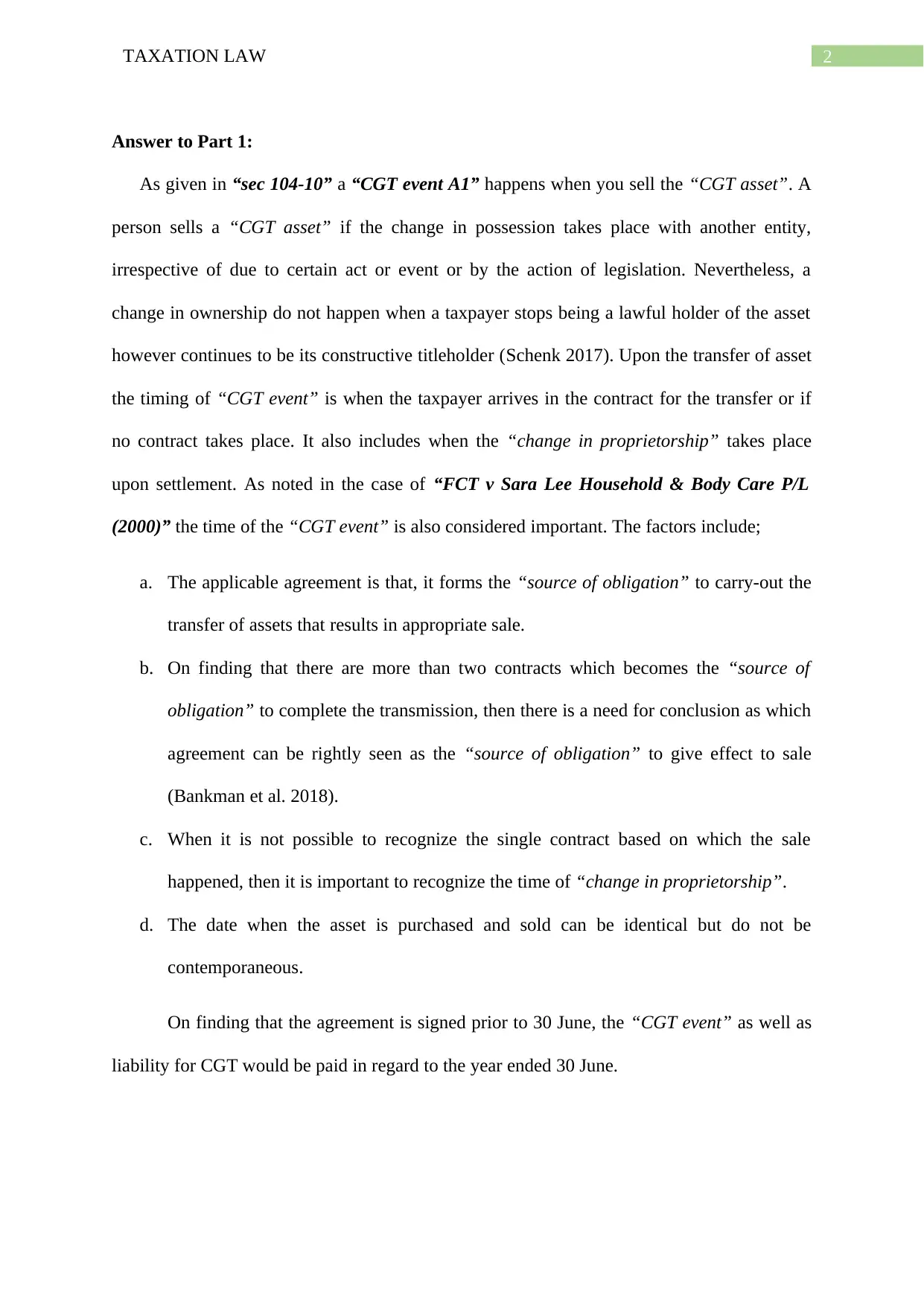
2TAXATION LAW
Answer to Part 1:
As given in “sec 104-10” a “CGT event A1” happens when you sell the “CGT asset”. A
person sells a “CGT asset” if the change in possession takes place with another entity,
irrespective of due to certain act or event or by the action of legislation. Nevertheless, a
change in ownership do not happen when a taxpayer stops being a lawful holder of the asset
however continues to be its constructive titleholder (Schenk 2017). Upon the transfer of asset
the timing of “CGT event” is when the taxpayer arrives in the contract for the transfer or if
no contract takes place. It also includes when the “change in proprietorship” takes place
upon settlement. As noted in the case of “FCT v Sara Lee Household & Body Care P/L
(2000)” the time of the “CGT event” is also considered important. The factors include;
a. The applicable agreement is that, it forms the “source of obligation” to carry-out the
transfer of assets that results in appropriate sale.
b. On finding that there are more than two contracts which becomes the “source of
obligation” to complete the transmission, then there is a need for conclusion as which
agreement can be rightly seen as the “source of obligation” to give effect to sale
(Bankman et al. 2018).
c. When it is not possible to recognize the single contract based on which the sale
happened, then it is important to recognize the time of “change in proprietorship”.
d. The date when the asset is purchased and sold can be identical but do not be
contemporaneous.
On finding that the agreement is signed prior to 30 June, the “CGT event” as well as
liability for CGT would be paid in regard to the year ended 30 June.
Answer to Part 1:
As given in “sec 104-10” a “CGT event A1” happens when you sell the “CGT asset”. A
person sells a “CGT asset” if the change in possession takes place with another entity,
irrespective of due to certain act or event or by the action of legislation. Nevertheless, a
change in ownership do not happen when a taxpayer stops being a lawful holder of the asset
however continues to be its constructive titleholder (Schenk 2017). Upon the transfer of asset
the timing of “CGT event” is when the taxpayer arrives in the contract for the transfer or if
no contract takes place. It also includes when the “change in proprietorship” takes place
upon settlement. As noted in the case of “FCT v Sara Lee Household & Body Care P/L
(2000)” the time of the “CGT event” is also considered important. The factors include;
a. The applicable agreement is that, it forms the “source of obligation” to carry-out the
transfer of assets that results in appropriate sale.
b. On finding that there are more than two contracts which becomes the “source of
obligation” to complete the transmission, then there is a need for conclusion as which
agreement can be rightly seen as the “source of obligation” to give effect to sale
(Bankman et al. 2018).
c. When it is not possible to recognize the single contract based on which the sale
happened, then it is important to recognize the time of “change in proprietorship”.
d. The date when the asset is purchased and sold can be identical but do not be
contemporaneous.
On finding that the agreement is signed prior to 30 June, the “CGT event” as well as
liability for CGT would be paid in regard to the year ended 30 June.
⊘ This is a preview!⊘
Do you want full access?
Subscribe today to unlock all pages.

Trusted by 1+ million students worldwide
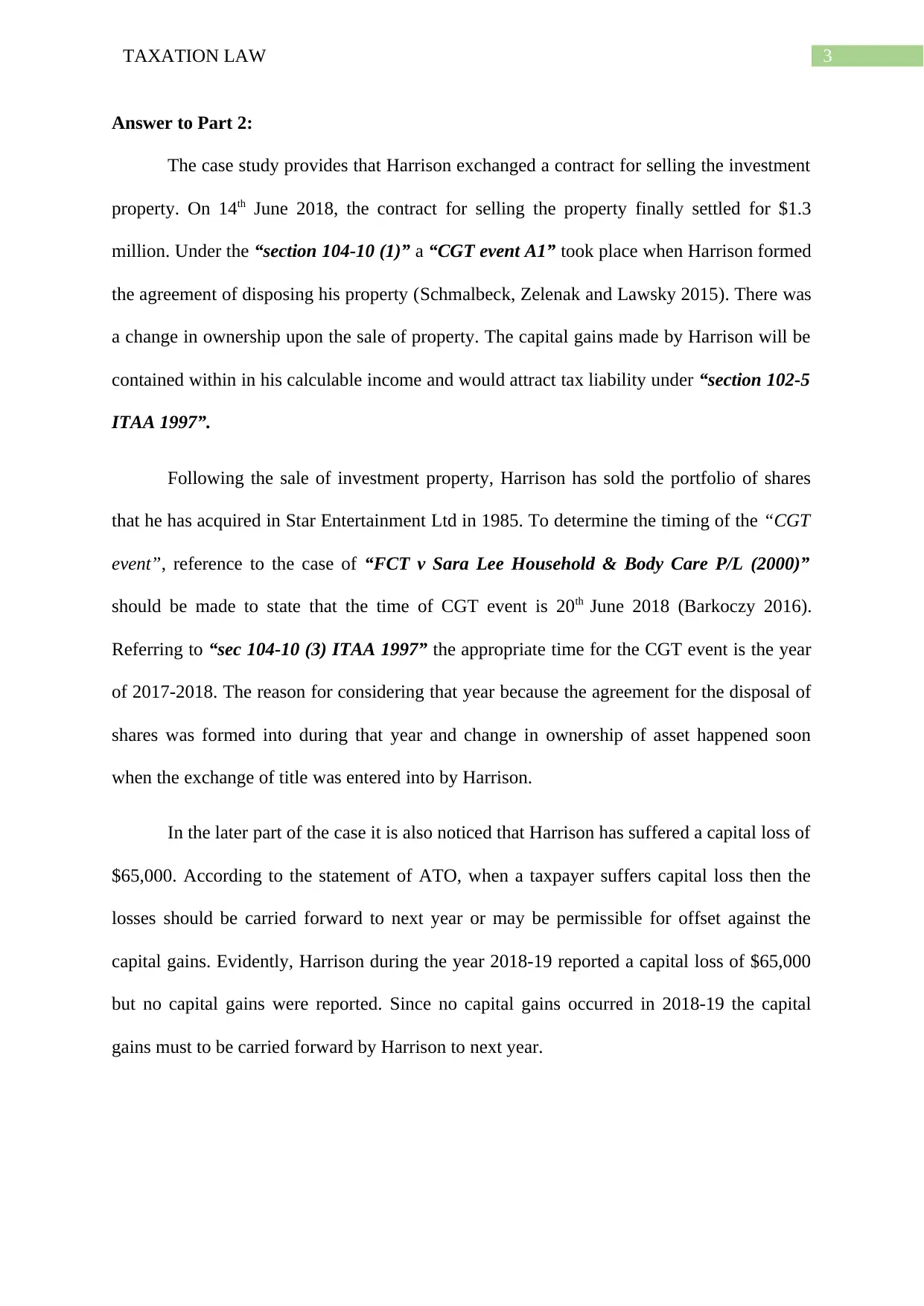
3TAXATION LAW
Answer to Part 2:
The case study provides that Harrison exchanged a contract for selling the investment
property. On 14th June 2018, the contract for selling the property finally settled for $1.3
million. Under the “section 104-10 (1)” a “CGT event A1” took place when Harrison formed
the agreement of disposing his property (Schmalbeck, Zelenak and Lawsky 2015). There was
a change in ownership upon the sale of property. The capital gains made by Harrison will be
contained within in his calculable income and would attract tax liability under “section 102-5
ITAA 1997”.
Following the sale of investment property, Harrison has sold the portfolio of shares
that he has acquired in Star Entertainment Ltd in 1985. To determine the timing of the “CGT
event”, reference to the case of “FCT v Sara Lee Household & Body Care P/L (2000)”
should be made to state that the time of CGT event is 20th June 2018 (Barkoczy 2016).
Referring to “sec 104-10 (3) ITAA 1997” the appropriate time for the CGT event is the year
of 2017-2018. The reason for considering that year because the agreement for the disposal of
shares was formed into during that year and change in ownership of asset happened soon
when the exchange of title was entered into by Harrison.
In the later part of the case it is also noticed that Harrison has suffered a capital loss of
$65,000. According to the statement of ATO, when a taxpayer suffers capital loss then the
losses should be carried forward to next year or may be permissible for offset against the
capital gains. Evidently, Harrison during the year 2018-19 reported a capital loss of $65,000
but no capital gains were reported. Since no capital gains occurred in 2018-19 the capital
gains must to be carried forward by Harrison to next year.
Answer to Part 2:
The case study provides that Harrison exchanged a contract for selling the investment
property. On 14th June 2018, the contract for selling the property finally settled for $1.3
million. Under the “section 104-10 (1)” a “CGT event A1” took place when Harrison formed
the agreement of disposing his property (Schmalbeck, Zelenak and Lawsky 2015). There was
a change in ownership upon the sale of property. The capital gains made by Harrison will be
contained within in his calculable income and would attract tax liability under “section 102-5
ITAA 1997”.
Following the sale of investment property, Harrison has sold the portfolio of shares
that he has acquired in Star Entertainment Ltd in 1985. To determine the timing of the “CGT
event”, reference to the case of “FCT v Sara Lee Household & Body Care P/L (2000)”
should be made to state that the time of CGT event is 20th June 2018 (Barkoczy 2016).
Referring to “sec 104-10 (3) ITAA 1997” the appropriate time for the CGT event is the year
of 2017-2018. The reason for considering that year because the agreement for the disposal of
shares was formed into during that year and change in ownership of asset happened soon
when the exchange of title was entered into by Harrison.
In the later part of the case it is also noticed that Harrison has suffered a capital loss of
$65,000. According to the statement of ATO, when a taxpayer suffers capital loss then the
losses should be carried forward to next year or may be permissible for offset against the
capital gains. Evidently, Harrison during the year 2018-19 reported a capital loss of $65,000
but no capital gains were reported. Since no capital gains occurred in 2018-19 the capital
gains must to be carried forward by Harrison to next year.
Paraphrase This Document
Need a fresh take? Get an instant paraphrase of this document with our AI Paraphraser
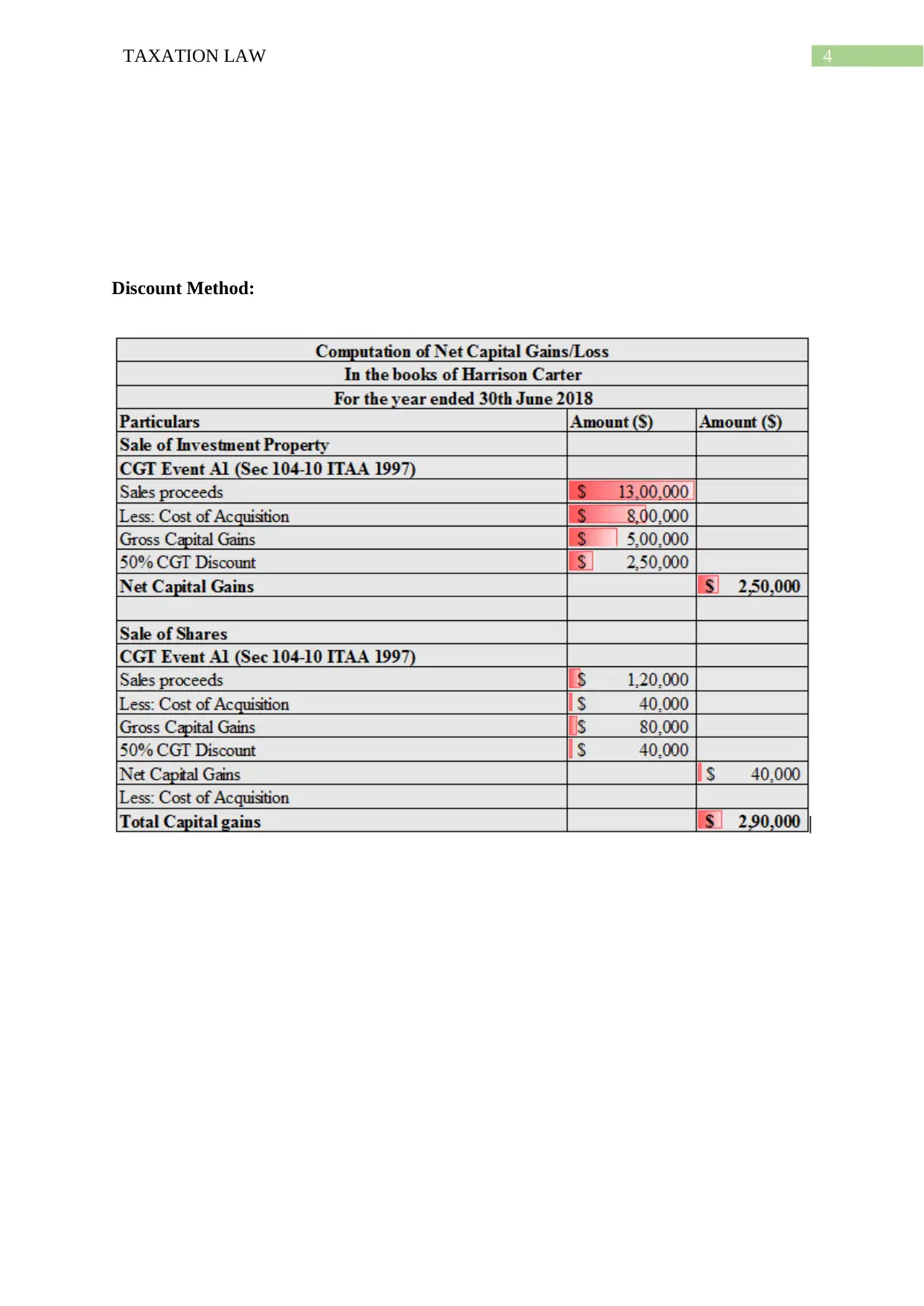
4TAXATION LAW
Discount Method:
Discount Method:
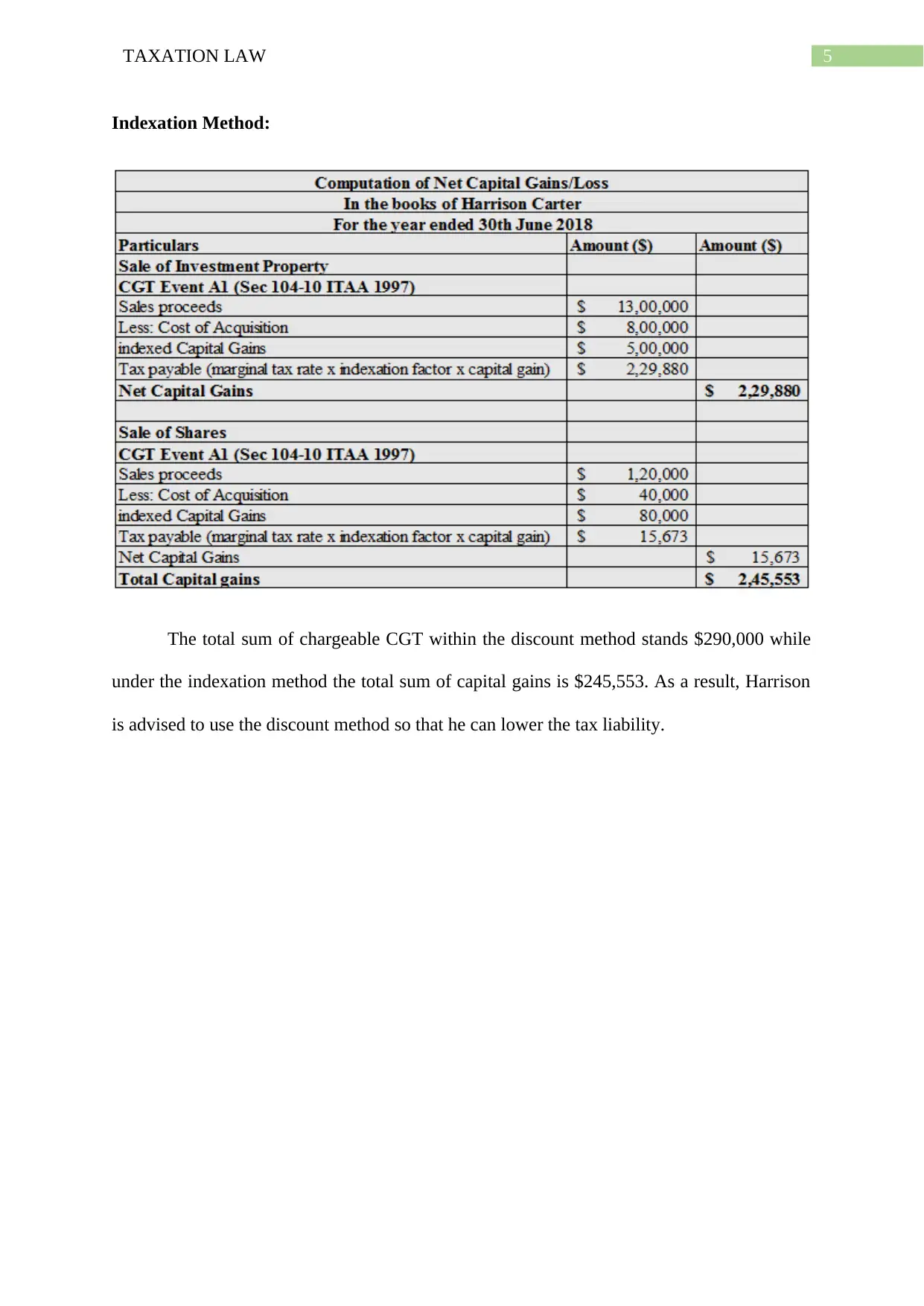
5TAXATION LAW
Indexation Method:
The total sum of chargeable CGT within the discount method stands $290,000 while
under the indexation method the total sum of capital gains is $245,553. As a result, Harrison
is advised to use the discount method so that he can lower the tax liability.
Indexation Method:
The total sum of chargeable CGT within the discount method stands $290,000 while
under the indexation method the total sum of capital gains is $245,553. As a result, Harrison
is advised to use the discount method so that he can lower the tax liability.
⊘ This is a preview!⊘
Do you want full access?
Subscribe today to unlock all pages.

Trusted by 1+ million students worldwide
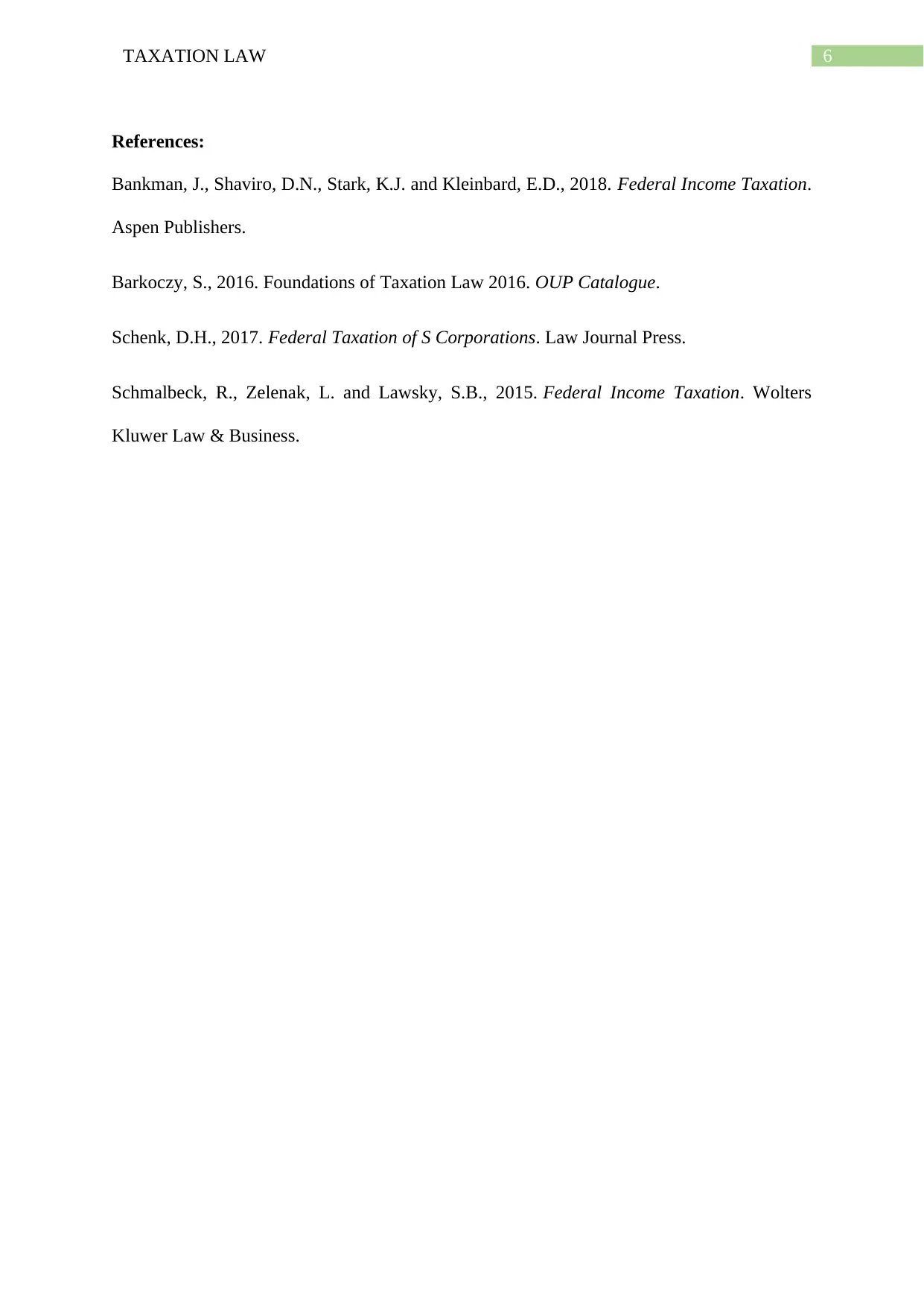
6TAXATION LAW
References:
Bankman, J., Shaviro, D.N., Stark, K.J. and Kleinbard, E.D., 2018. Federal Income Taxation.
Aspen Publishers.
Barkoczy, S., 2016. Foundations of Taxation Law 2016. OUP Catalogue.
Schenk, D.H., 2017. Federal Taxation of S Corporations. Law Journal Press.
Schmalbeck, R., Zelenak, L. and Lawsky, S.B., 2015. Federal Income Taxation. Wolters
Kluwer Law & Business.
References:
Bankman, J., Shaviro, D.N., Stark, K.J. and Kleinbard, E.D., 2018. Federal Income Taxation.
Aspen Publishers.
Barkoczy, S., 2016. Foundations of Taxation Law 2016. OUP Catalogue.
Schenk, D.H., 2017. Federal Taxation of S Corporations. Law Journal Press.
Schmalbeck, R., Zelenak, L. and Lawsky, S.B., 2015. Federal Income Taxation. Wolters
Kluwer Law & Business.
1 out of 7
Related Documents
Your All-in-One AI-Powered Toolkit for Academic Success.
+13062052269
info@desklib.com
Available 24*7 on WhatsApp / Email
![[object Object]](/_next/static/media/star-bottom.7253800d.svg)
Unlock your academic potential
Copyright © 2020–2025 A2Z Services. All Rights Reserved. Developed and managed by ZUCOL.





